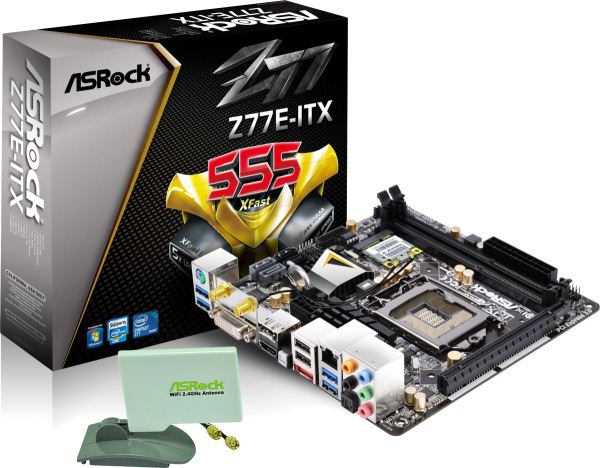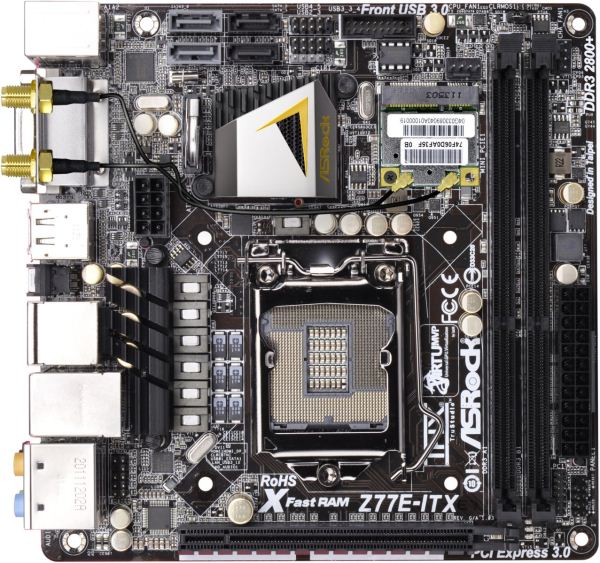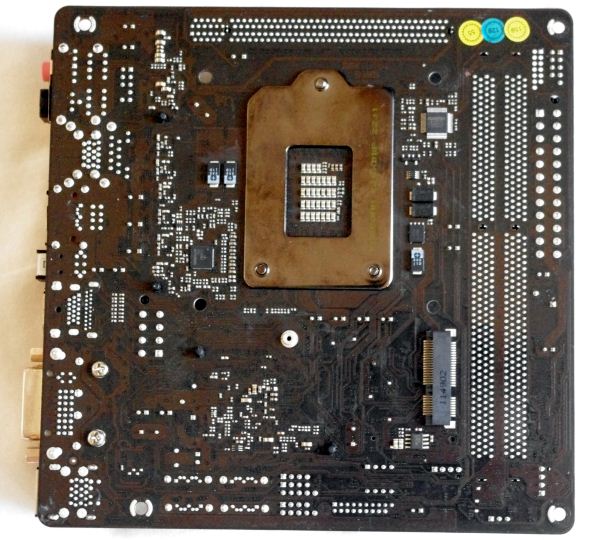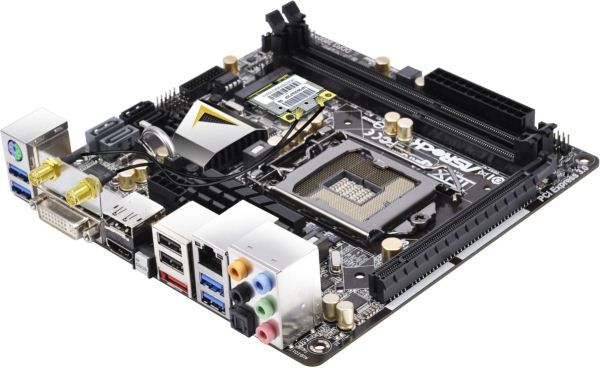Z77 mITX Round-Up: Five of the Best – MSI, Zotac, ASRock, EVGA and ASUS
by Ian Cutress on December 31, 2012 7:00 AM EST- Posted in
- Motherboards
- MSI
- ASRock
- EVGA
- ZOTAC
- Asus
- Ivy Bridge
- Z77
- mITX
ASRock Z77E-ITX Overview
Before I even started testing the ASRock Z77E-ITX, I could see murmurings online in the various forums I use about it. For the interests of remaining unbiased, I steered away from those threads. The ideal scientific test of a motherboard would be a double-blind study – the board can be reviewed and tested, but any tell-tale signs or markings on the product pointing it towards a single manufacturer would be removed. Unfortunately testing is not always scientifically perfect, but we can at least be as thorough as possible in our analysis.
The ASRock Z77E-ITX presents the user with a novel way (in the consumer desktop space) of solving the issue of limited PCB area – moving components to the rear of the motherboard. We are not talking just resistors – ASRock have moved the mSATA port to the rear. This frees up the main topside of the PCB for a mini-PCIe with 802.11b/g/n WiFi, a proper location for the 8-pin CPU connector, an easier-to-remove BIOS chip, and a lot more components on the board. This thing looks filled.
Other functionality on board gives us a Broadcom BCM57781 network controller, the Realtek ALC898 audio codec and an ASMedia ASM1042 USB 3.0 controller. The two 4-pin fan headers are found on the top left of the board, although on closer inspection the power delivery chokes may give cause for concern. Their open top design suggests iron core chokes, similar to those used on low end motherboards, rather than the iron powder or alloyed chokes on their higher end models. However after talking to ASRock, these are actually iron ferrite chokes, used for small space / high power systems such as servers. This should lead to reasonable temperatures under severe stress, and typically server parts are rated to be more than adequate for that severe stress.
The BIOS of the Z77E-ITX uses the older UEFI design of white on blue, compared to the new starry background design and distribution of options. We still get access to the System Browser, which cunningly gives a peak of the back of the board due to that mSATA placement, the Online Management Guard and Internet Flash for BIOS updates through the internet. We also get the dehumidifier functionality for equilibrating high-moisture situations inside and outside the case to reduce condensation in those climates. Software is standard ASRock, with ASRock always wanting to promote their XFast 555 system of RAM, LAN and USB. The latter may not be of use under Windows 8, and the chances of RAM cache use in a mITX are slim, but access over the network priority is a useful tool to have. While the fan controls are not the best, they did work in my testing over the range of tools available.
The ASRock Z77E-ITX sits at the low end in terms of cost in our review at $150 – significantly cheaper than the EVGA at least. With a weird orthogonal antenna in the box, DVI-I to D-Sub adaptor too, and performance which is not too far off from what we expect from the platform, the ASRock does pull at the wallet waiting for a build.
Visual Inspection
Like most motherboard manufacturers at the minute, ASRock has their color scheme – in this case we the aim is for a gold and black combination, however the way ASRock designs its motherboards means that we also get a lot of white. This is due to the placement of the components via SMT – in order to guide the automated process which places the components on board, each component has a small white box around where it should be. All these boxes printed on the board means that technically ASRock has less space to place components, and it alters the aesthetic perception of the product in the end.
Starting with the socket placement, ASRock like others in this review have placed the socket underneath the chipset and up against the memory/PCIe slots. This restricts coolers to the x-y dimensions specified by Intel, unless one invests in low profile memory. As always with mITX gaming builds, I would recommend an all-in-one liquid cooler. The socket area has access to both of the CPU fan headers on board – the 4-pin CPU header is above the mini-PCIe slot, and the 4-pin chassis header is to the top right of the memory slots. Arguably placing the two fan headers close together may not be the best idea in terms of placement.
The rear of the board is where we find this mSATA port. Now that mSATA drives are below the $1/GB, they become a wonderfully viable option in the motherboard space for those wanting to save space or who are not going RAID-0. (Even though there could be scope for two mSATA on motherboards in the future.)
North of the socket we have the chipset heatsink, which ASRock have decided not to connect to the power delivery heatsink. As mentioned previously, the style of the chokes used in the power delivery seems to suggest that simple iron cores are being used. Simple iron cores are the current low end and cheaper implementation of chokes, leading to lower efficiency and high heat loss, especially when compared to iron powder chokes, alloy chokes, super ferrite chokes, or PowIRstages. Talking with ASRock points these chokes towards the iron ferrite versions used in servers, meaning that they should still be able to provide enough power during overclocks, even if the mITX motherboard is not the ideal place to start overclocking a motherboard to the fullest – especially given that Ivy Bridge processors can get very hot in correlation to their voltage.
Around the chipset heatsink we get the SATA ports – two SATA 6 Gbps and two SATA 3 Gbps. The motherboard battery is stood straight out of the motherboard in order to save space, and below this we have the 8-pin ATX power connector. This is still in the middle of the board but perhaps not as bad as other implementations which require the power cables to stretch over everything in order to get to it. To the right of the chipset we have a USB 3.0 header, as well as the mini-PCIe port with a 2.4 GHz 802.11b/g/n WiFi module already strapped to it.

The rear IO panel looks more like a standard ATX build rather than a mITX oriented one. From left to right we have a combination PS/2, two USB 3.0 from an ASMedia ASM1042, the two antenna ports, a DVI-I, HDMI, DisplayPort, a Clear_CMOS button, two USB 2.0, an eSATA, a Broadcom BCM57781 network port, two USB 3.0 from the chipset and audio jacks containing an optical SPDIF output.
Board Features
| ASRock Z77E-ITX | |
| Price | Link |
| Size | Mini ITX |
| CPU Interface | LGA-1155 |
| Chipset | Intel Z77 |
| Memory Slots |
Two DDR3 DIMM slots supporting up to 16 GB Up to Dual Channel, 1066-2800 MHz |
| Video Outputs |
HDMI DisplayPort DVI-I |
| Onboard LAN |
Broadcom BCM57781 802.11 b/g/n WiFi |
| Onboard Audio | Realtek ALC898 |
| Expansion Slots |
1 x PCIe 3.0 x16 1 x mSATA 1 x mPCIe |
| Onboard SATA/RAID |
2 x SATA 6 Gbps (Chipset) RAID 0, 1, 5, 10 2 x SATA 3 Gbps (Chipset) RAID 0, 1, 5, 10 1 x mSATA 3 Gbps (Chipset) 1 x eSATA 3 Gbps (Chipset) |
| USB |
4 x USB 3.0 (Chipset) [2 back panel, 2 onboard] 2 x USB 3.0 (ASMedia ASM1042) [2 back panel] 6 x USB 2.0 (Chipset) [2 back panel, 4 onboard] |
| Onboard |
2 x SATA 6 Gbps 2 x SATA 3 Gbps 1 x mPCIe (Used by WiFi b/g/n) 1 x mSATA 3 Gbps (on rear) 2 x USB 2.0 Headers 1 x USB 3.0 Header 2 x Fan Headers 1 x Front Panel Audio |
| Power Connectors |
1 x 24-pin ATX Power Connector 1 x 8-pin CPU Power Connector |
| Fan Headers |
1 x CPU (4-pin) 1 x CHA (4-pin) |
| IO Panel |
1 x Combination PS/2 Port 2 x Antenna 1 x DVI-I 1 x HDMI 1 x DisplayPort 1 x Clear_CMOS Button 2 x USB 2.0 1 x eSATA 3 Gbps 1 x Broadcom NIC 4 x USB 3.0 1 x Optical SPDIF Output Audio Jacks |
| Warranty Period | 3 Years |
| Product Page | Link |
Compared to the other boards in the review, the use of a Realtek ALC898 is good to see, whereas the Broadcom BCM57781 NIC is an unknown factor. I like the mSATA and mPCIe combination, and putting the mSATA on the rear of the board is a great idea – it means that in the future other items such as the battery or SATA ports may migrate there as well. Price wise the ASRock board comes in as one of the cheapest in this review, and given the inclusions in the package (shown later), it makes it a nice product all around from a technical standpoint. The only additions I would have liked to have seen onboard is a two-digit debug, and if possible, power/reset buttons.














54 Comments
View All Comments
ryedizzel - Monday, December 31, 2012 - link
Thank you so much for this Z77 roundup as I'm currently shopping for a new mobo and have been piecing together reviews from various sites. But as usual I always check here first, then Tom's, then Hardocp (in that order). Keep up the great work in 2013!Aikouka - Monday, December 31, 2012 - link
Ah, if only I held off on building my silent HTPC for a little bit longer. The hardest part about working with a Streacom case (other than building it) is finding a good motherboard that doesn't put too much in the way of the heat pipes. That's one reason why I was considering going with a board with mSATA, and I'm pretty certain that I stumbled across that ASRock board. Unfortunately, I looked at the photos, and didn't see a mSATA port, so I passed on it. Who would have thought to look at the back? Boy, do I feel like a bit of a dummy now! =$Although, speaking of the back mSATA connector, I recall seeing you touch on it on the recommendation page, but do you think it would work well on most cases? If I remember correctly, mSATA drives are fairly thin, so it might be fine. Going back to the Streacom, it does look like the ASRock offering would work well in regard to clearance even disregarding the mSATA port as the light gray SATA ports should clear the heat pipes. The USB3 port won't though.
philipma1957 - Monday, December 31, 2012 - link
I built 2 asrock builds with the msata as the only drive. btw this z77 review with no regard to oc is pretty weird.I have a 3770k with a hd7970 gpu and an msata in a small case the cooler master elite it is a very fast powerful machine. I use the asrock and love it. it does have a flaw the msata slot is sata II
Ananke - Monday, December 31, 2012 - link
I have i3-3225 (the same as in the article). In my opinion, for the money, the best is ASUS P8H77-I.It does have 6 SATA ports - a must for a file server. So, basically install Windows 8 on a SSD, add HDDs and create Storage Space - 5 SATA will allow you to create software RAID 5, without the need of SATA extension controller. BIOS is nice and stable. The board is $100 on Newegg.
The ASUS Z77 Deluxe is nice, if anybody needs all the additional functionality in a small form factor. However, only 4 SATA - means no good for video, file, backup server. You get the "overclocking" ability though. I doubt how practical is overclocking into so small space, probably to a handful of people. Teh board costs $185.
So, I would say $100 is better than $185, plus you get all the 6 SATA ports - priceless.
DarkStryke - Monday, December 31, 2012 - link
Not everyone who games wants to have a huge tower. I've built more then one system based around the silverstone FT03-mini that runs a 3750k / Z77 deluxe-i and a GTX 670.I bring mine to lan parties and people are amazed at the power in such a small box, and it's just as fast as any desktop single GPU alternative.
Ananke - Monday, December 31, 2012 - link
ASUS P8H77-I is a mini ITX board - the cheaper variant of the reviewed deluxe board. It costs $100.ggathagan - Wednesday, January 2, 2013 - link
I agree; the H77 makes much more sense for most ITX builds.I built a system with the P8H77-I, a GTX670 and the FT03-MINI.
I don't think the daughter card of the Z77 Deluxe would have fit in the case.
tramways - Monday, December 31, 2012 - link
I registered here because the reviewer is lamenting that some boards use the ALC889 instead of the ALC892 codecs.The 889 like the 882 before it and the 898 after it is a much better codec than the 892.
The 883,888,892 codecs are the cheaper low performance DAC/ADC chips.
I would buy a board with the ALC889 or preferably the ALC898,but not with the ALC892.
all the best in 2013
Paul
limki - Monday, December 31, 2012 - link
too bad I already ordered mine last week ... MSI Z77IAto tell the truth, i don't really mind [ at 136€ its a bit pricier than asrock with my supplier]
the conclusion for this board seems a bit biased to me
but hey, if you're not looking for a tiny powerhouse, you don't need z77
- in SUGO 05(and most small cases), MB is horizontally and PSU is above it, so cables and airflow will always be nasty
- using a discrete GPU, you don't care about not having DVI or DP
- no additional controller (USB/SATA) -> I don't plan on using more than 2(won't fit into case), so why bother?
//btw is the SATA 6/3/m correct 2+2? shouldn't be also 2+2+1?
- and if I'm to take the "military grade" stuff at least half seriously, ...
EnzoFX - Monday, December 31, 2012 - link
Do the post times include those pesky AHCI driver loading screen? I hate that it adds so much more to the boot process.